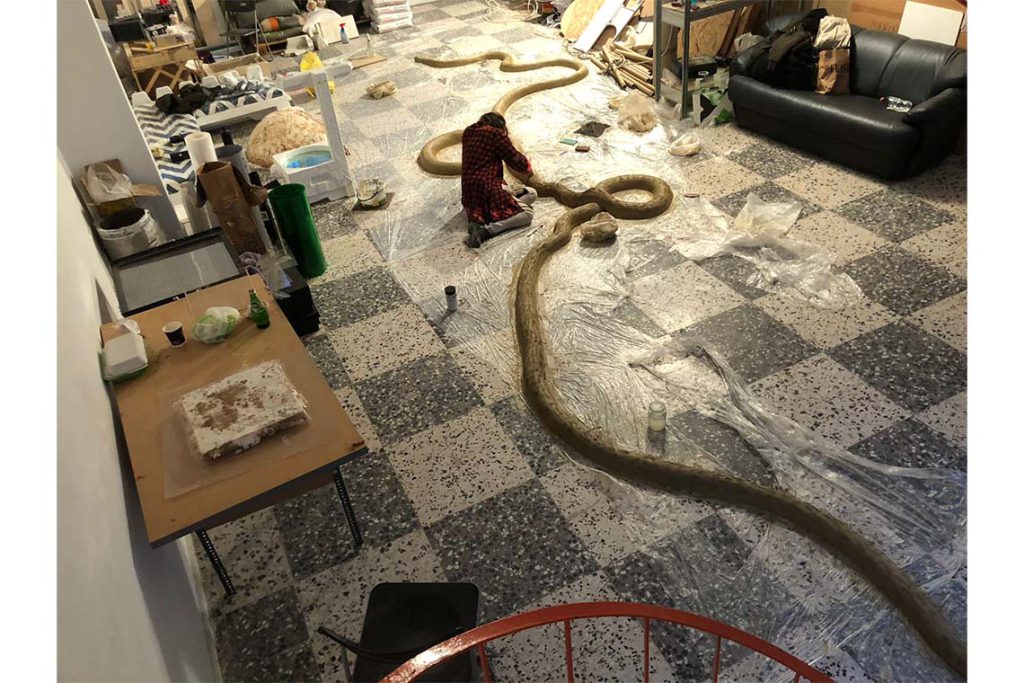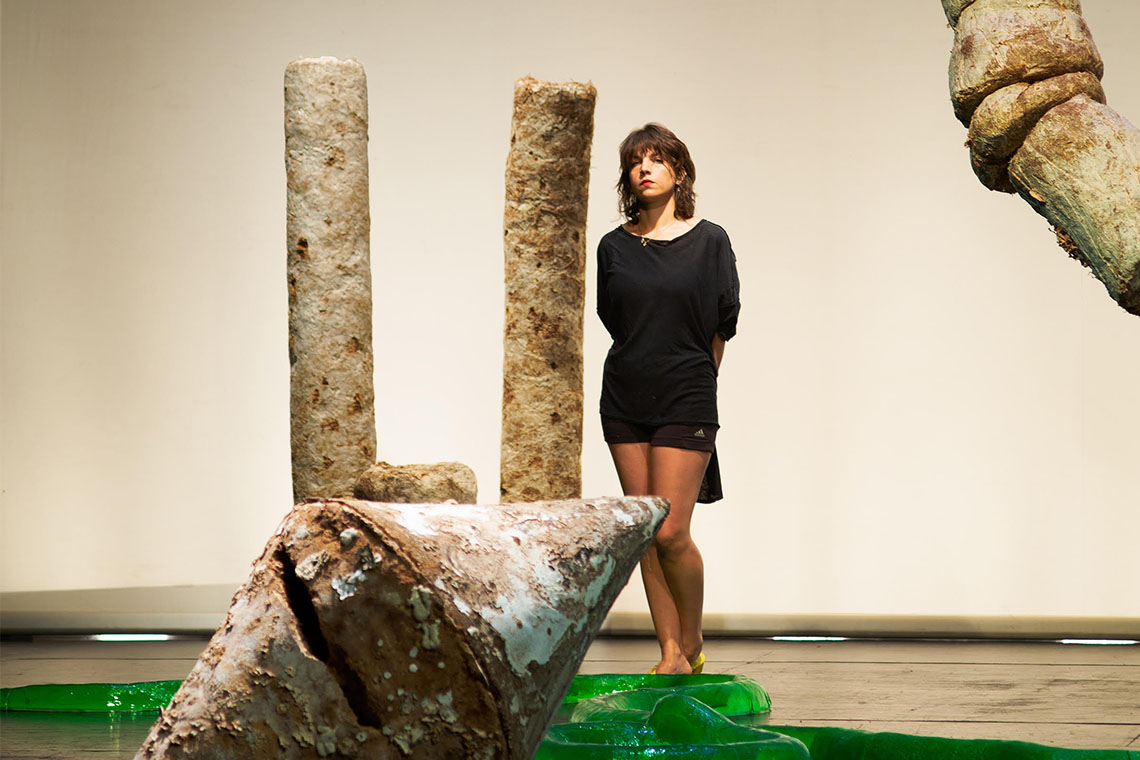The artist reveals how she learns about life from growing mushrooms and letting them occupy her art.
Last summer, Nour Mobarak learned that, somewhere in Greece, her art was being devoured. She had collaborated with a mushroom farm outside Athens for her mycelium sculptures, which were exhibited on the stage at the Municipal Theatre of Piraeus. When the mushrooming process of her work gave harvest inside climate-conditioned giant silos, the farmers packaged the crops and released them into grocery stores with various kinds of local fungi. “People were eating my sculptures!” Mobarak quips.
These days, visitors to New York’s MoMA are consuming – visually – Dafne Phono, her sonic installation of 15 mycelium forms which overall orchestrates an enigmatic interpretation of the world’s first traditional opera, Dafne. In the layout of earthy-toned abstract sculptures, each figure stands in to represent a mythical character from the single-act libretto which was initially staged by Jacopo Peri and Ottavio Rinuccini in 1598 at the Palazzo Corsi in Florence. The Lebanese-American artist’s unconventional adaptation strips away the capricious tragedy of love, jealousy, ego and metamorphosis from its original Italian language. Instead, Mobarak gives the characters of Apollo, Ovid, Daphne, Cupid and Python, as well as the Greek chorus, voices in languages under the most critical risk of extinction through speakers embedded inside each figure.

Image courtesy of the artist and Miguel Abreu Gallery, New York
“Opera is an investigation into human voice,” says Mobarak, who underlines that her work “is not opera at all”. She instead connects with “the body as a functioning instrument in a sociopolitical context”. A journey into the potentials of human phonetics, the project embodies how semantics, as well as the mythologies and histories that shape them, continue to affect our ways of being. “We are living in a society where the voices we use are being limited by hegemony, by capitalism, and by how English language is taking over everything,” says the Seattle-based artist, whose mixed-media work spans performance, text and fungus sculptures, which she composes by feeding them.
Intercontinental research took Mobarak around Africa in search of the “widest palette of vocal sounds” for her operatic composition. She emphasises that her intention is far from “fetishising” any group or community, but her study also proved that “some of the most phonetically complex languages are also the oldest ones still spoken”.
While travelling around Namibia and the Kalahari Desert to hear the San people speak, Mobarak found herself listening to a melodic language which has 144 phonemes, five click sounds and numerous dialects. Eventually, she granted the Western !Xoo dialect to the rebellious nymph protagonist Daphne. The winged love god Cupid sings in the Abkhaz language from the northwest Caucasus; the son of Zeus and archetypal masculine deity, Apollo, remains in the original Italian. The matriarchal force of fertility, Venus, delivers her lines in the Canary Islands’ chirping dialect Silbo Gomero, in which each vowel and consonant is a whistle. The chorus utters their echoing comments in a Chatino language whose around 40,000 speakers today inhabit Mexico’s Oaxaca region. The alchemy of all languages recited concurrently creates a Babylon-like symphony of a poetic chaos. “Baffling and of course incomprehensible,” explains Mobarak about the installation of “de-creation where sound and meaning start to dissolve”. She conjures an alternative operatic realm in which “the voices are music in a composition of utterances”.

The earthy essence of Mobarak’s sculptures is derived from two types of fungi. Turkey Tail is known for its medical properties and is the artist’s favourite, thanks to its “marbly ancient ruin-looking” surface. The second type, the more common oyster mushroom, is the one that made its way from Mobarak’s sculptures into people’s kitchens in Athens, where she produced the work. The process of the crops metamorphosing into mycelium fascinates the artist for witnessing nature’s own shape-shifting ritual. “I am able to break and reassemble the shapes,” she explains. As a sculptor, she is intrigued by the stage of relinquishing control when nature intervenes to bear the yield. Mobarak finds a parallel between her waiver of physical command and sourcing a canonised text about mythical figures trying to control one another for her sculptures.
Once the mycelium is formed, she can mould and sculpt the material. Cupid, the show’s only figurative form, embodies the baby angel of love in his commonly accepted silhouette. “There is a dialogue there between me and the material, where the patterning happens totally outside of my control,” adds Mobarak. “I decide the sculpture’s shape, but the surface is what the mycelium decides.” This tugging between deliberation and chance also bears an inimitable quality for each formation: “There is no way to repeat a pattern that a mushroom has given.”
Besides Cupid, other characters assume abstracted bodily representations which the artist calls “platonic ideals of a shape”. Venus, for example, is a double-sided cone laid on the floor not far from Apollo, who finds his corporality in an oblong sphere. The titular nymph stretches horizontally like the thick branch of a centuries-old tree. Ten tube forms erected at different heights represent the chorus. The artist considers it “impossible to make work that isn’t at its heart about perception and how we perceive shifting things”. Python is the only character who is created outside of mycelium – rather, a vacuumed plaster, the serpent crawls on the floor with the alertness of its neon green skin. The spectral appearance alludes to the fact that Apollo in fact kills the snake before the events start unfolding in the first scene.

Image courtesy of the artist and Sylvia Kouvali, London / Piraeus
Mobarak landed on mycelium through a curiosity for other ecosystems around, and even within, her. “We are always processing spores and bacteria, and there are organic forms that we constantly breathe,” she says. A mushroom-growing workshop which she decided to sign up for after a break-up led to a practice which in fact helps the artist materialise her work and process life through observing the strangest yet beautiful formations. “They looked like limestone or marble,” she remembers about her early experiments with growing fungal colonies in 2017. “They proved to be perfect solutions to problems I was having within my work.”
Logistique Elastique, Mobarak’s first solo exhibition in New York, showed at Miguel Abreu Gallery in 2021 and featured six mycelium spheres, one of which was grown within a colourful vinyl beach ball with the fungi protruding from its surface. A framed work had a flat layer of DNA-carrying materials from her ex-lovers, also consumed by mycelium. “The body is a constant subject for me,” she says, “other bodies, non-human bodies, interspecies. The body is a carrier of so many temperaments and ambitions, it’s a crazy sculpture and mystery.” She observes the life cycle of fungi to help make sense of our own bodily habits. “I let things take over my work and even eat it,” she muses. “Those functions outside my control help me observe some kind of truth.”
If opera is an erratically-emoted avatar of life, why not let Earth’s very own microorganisms help consume and reproduce its dramatic flamboyance? Mobarak inlaid glass into the sculptures by sewing the beads into cardboard. After mycelium ate the heavy paper surface, the fungi blended with the shiny glass. “Early opera characters wore glass beads all over themselves to be noticed on stage,” says the artist. “My sculptures similarly have this life force coming out of their skins.”



